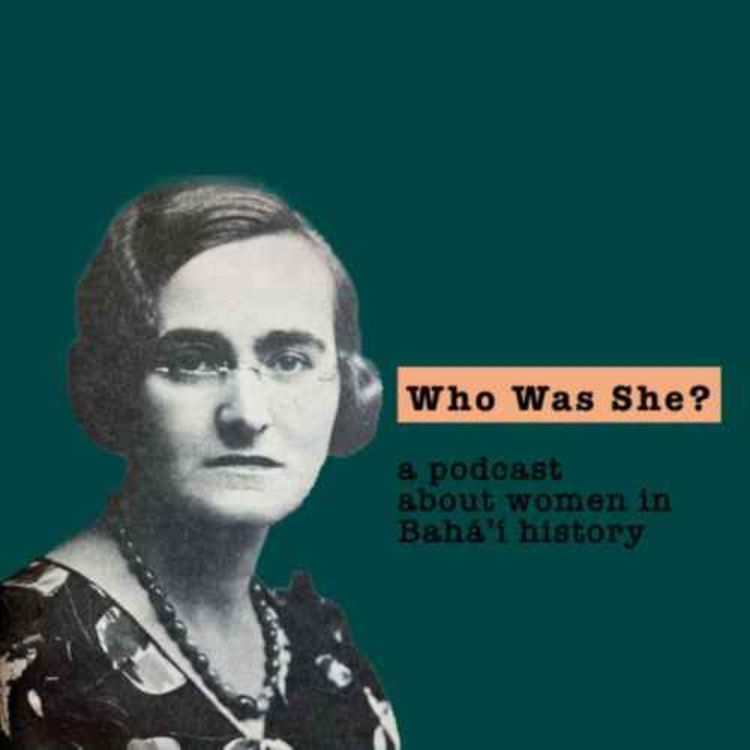Share

Who Was She?
Teaching in Europe
In this episode, we hear how Lidia began to travel around Europe to teach Esperanto, spoke at conferences about the importance of unity as the Nazi Party grew more powerful, and how she gained confidence that her passion work was making a difference. Listen to excerpts from some of her talks and more in the latest episode of Who was she? Podcast!
Transcript:
Bonvenon al Who was she? Podcast where I, Tara Jabbari share the stories of women throughout Baha’i history. This season is about the life of Lidia Zamenhof, an esperantist and Baha’i who traveled through three continents to teach languages in efforts to bring unity to humankind.
Upon returning from her pilgrimage, Lidia attended the Universal Congress of Esperanto in June 1930, held in Oxford, England. During her time there, she would learn more and eventually become a certified Cseh teacher of Esperanto.
The Cseh method was created by a Romanian Catholic priest, Andrei Cseh. He developed the technique which utilized blackboards and paper for the first few classes and by speaking in simple Esperanto about everyday subjects. Gradually the class teaches grammar and broader vocabulary of the language. After 40 hours, students were expected to have a basic ability to communicate in Esperanto.
Lidia was intrigued and impressed by the Cseh Method and began to study it so could train and educate others.
For the teachers of the Method, the style was very demanding, requiring the teacher to present during the entire class.
The direct method would start with the teacher speaking to the class in Esperanto about everyday subjects. For instance, they would learn about different animals or malsamaj bestoj and other objects. Eventually, the students would learn more about it’s grammar and vocabulary and could discuss fluently about various subjects like
la historio kaj spertoj de mondmilito unu or the history and experiences of World War I.
For Lidia, the method was tiring but it was her mission and passion, to teach Esperanto as effectively as she could. Her students later wrote that when she spoke during her classes, “ she spoke slowly, very clearly, with a strong but at the same time gentle voice. She was always there when we needed her.’
She also spoke at the Baha’i Meeting during the Congress where 60 Esperantists attended. Her speech concentrated on the topic of “Man, God, Prophet.” People who read and saw her work during these Congresses wrote and commented that she was an eloquent speaker, able to captivate despite her small stature. Her passions came right off the page and spoke to any who were present.
Some Esperantists like Professor Odo Bujwid from the University of Krakow openly disapproved of Lidia’s Baha’i activities. He and even family members warned Lidia not to mix her Baha’i activities with Esperanto. This pained Lidia as she would never do anything to damage Esperanto and her father’s work. Other Esperantists like Andrei Cseh, was a friend and supported Lidia for combining both passions.
Lidia continued to work on translating Baha’i Writings from English to Esperanto, including one of the key books, the Kitab-i-Iqan, or The Book of Certitude. Martha Root was very proud of her spiritual daughter though she was worried Lidia would have a hard time being one of the few Baha’is in Poland, where she still mostly resided. Lidia lived with her sister and brother and his family so she did not have to work to make money. It allowed her to concentrate on teaching and translating which often paid little or nothing at all. Martha wrote, “She is a born translator, she has a genius for it, and the books she has translated into Esperanto will be a great “leaven” not only in Europe but also in the Far East. Her mind is keen and logical and I have met few people in my life more just than Lidia.”
In September, 1932, 28 year old Lidia decided to leave her home and become a traveling Esperanto teacher. She first left for Sweden teaching in small towns and at times, had over 250 people come to hear her speak and attend her classes. Here is an excerpt from one of her talks,
“We and the whole world, and the entire realm of creation attest to the Creator, Who, having given existence to all, remains Himself outside and above all. We cannot know His essence, we can only know Him through His creation. The essential teachings of all the prophets of the past were the same. Each of them brough rays of the same sun, each of them taught love - love of God, love of one’s fellow man. Although the prophets had disappeared from the material world, their words had not. The Divine Inspiration which spoke through the mouth of each of them did not die but, like a phoenix, is always reborn of its own ashes. In this day once again its song can be heard. Whoever has ears, let him hear.”
By the end of the year, she finished her time in Sweden and was asked by the French Esperantists to visit France and teach. Her first stop was Lyon, Dr. Andre Vedrine, who attended spoke that “Lidia Zamenhof was a remarkable teacher. Plain in appearance, she demonstrated a sprightliness and a joyful spirit which could leave non indifferent.”
After three weeks in Lyon, her pupils were fluent and spoke to Lidia in Esperanto only. It left her immensely proud of them and happy to see her service and work being paid off. She left Lyon writing, ‘although the day was cold, my eyes were sweating.” Lidia continued to travel throughout France, often speaking also about her father and that Esperanto was not merely a language but it was more of a spirit of unity and brotherhood among people.
1933 came around andthe annual Universal Congress of Esperanto was getting ready to be held in Cologne, Germany. However, Lidia decided not to attend. In the book, The War Against the Jews, it explains that between the two world wars, there were some seven hundred anti-Jewish periodicals in circulation in Germany and over four hundred anti-Semitic organizations. By March 1933, Hitler’s authority was established and the SS had set up the first concentration camps in Dachau, Germany.
The Esperanto movement in Germany was making a lot of attempts to accommodate itself to the Nazi regime and some Esperantists naively hoped that by renouncing Zamenhof, they could prevent the language from being suppressed.
Meanwhile, Lidia continued to travel around France. She admitted that she was home-sick and did not enjoy traveling but in order for her to accomplish the goal to teach Esperanto and unity, she knew she had to continue to do so. She wrote to Shoghi Effendi, the Guardian of the Baha’i Faith that she considered her work teaching Esperanto as a “part of the divine program for improving the conditions of the world.”
Lidia’s classes would have people from 50 to 150 attendees in France. After two years of traveling in Sweden and France teaching, she returned for a brief visit back home in Warsaw.
With her family, she attended the 26th Universal Congress of Esperanto where she was reunited with her spiritual mother, Martha Root.
She gave a talk that proved how much her few years of travel and teaching had shifted her focus and gave her purpose:
“There are people who believed and lost their faith. Oh, that is the fate of many of those who prayed but found their prayers unfulfilled; those who in sickness begged for health; those who in misery asked for help; those whom death robbed of their best beloved; finally millions of those who lived through the inferno of the war who, having avoided the bombs and gases, vainly eke out the most miserable existence. All those hopeless, rebellious ones ask: ‘Does God really exist? Where is He? How could He create so much misery and cause so many tears to flow?’
“Or it appears to these people that besides God another and equal power reigns in the world, which is the scene of an eternal battle between the good God and the prince of darkness.
‘The Baha’i teachings proclaim the nonexistence of evil. Is it possible to imagine a power which would be able to stand against the Creator of everything? To believe in Satan means in fact not to believe in God, for it means not to believe in His most essential attributes: His power over everything and His goodness…
“That which we call evil is only lack of good. Darkness is only lack of light. Blindness is only lack of vision. These are but passing circumstances, often created by ourselves. They will pass, for eternity is an attribute of God, and to Him only good belongs.
“One may say, on the contrary, that it is small consolation to the blind to assert that his blindness will pass - together with his life. But that is the view point of the short-sighted. For life does not pass…
“With full assurance the Baha’i Teachings assert the immortality of the human spirit. The body is only an instrument, which the spirit uses for a time to express itself. Even if the instrument becomes defective, the hand that uses it does not perish. The body is like a garment that becomes outworn and is cast away. But its wearer is not cast away along with the garment. The body is like a cage in which dwells the bird of the spirit, before it breaks the cage and flies to heavenly heights.
“And when bodily life shall cease, when the blind eyes are closed, other eyes will open and the joys of the spiritual world will recompense the sufferings of those who physical eyes saw not the brilliance of the material sun. ..
“What is true of man is also true of mankind. It also must learn the lesson of harmony, and that harmony it must find, before all else, in itself. It must be like a chord in which one note does not grate against another, but together with the others forms a beautiful harmony. It must be fragrant as a garden where many diverse flowers bloom one beside another. It must feel as one tree rich with many brother-leaves, one sea abounding with many brother-drops.”
After her speech, Martha remarked that the whole audience applauded and newspapers praised her speech.
Lidia spoke one more time during the Congress for the Union of Esperantist Women:
“In the work for peace, the first and chief place should belong to the women. War is an affair of men…the male love of power and authority…the result of that primitive social order which always had as its leader and ruler - the man.
But today women are rapidly rising from the low status they have held. In many respects they are now equal to men; in others, they surpass. That superiority exists in those spheres which deal with sensitivity and feeling, and this sensitivity dictates to us dislike of force and coercion.
For too many centuries, we women have been told that our main role in life is motherhood, and that is what we are suppose to remember. The feeling of a woman’s heart, especially a mother, must hate war, which destroys her nest and leads her dearly loved ones to the fields of horrible death. For a long time, men have said that the task of the woman is to give, and to look after the man. Let them then understand that no compromise is possible between us and war…
“Let us untie to bring peace to the war-tortured world. And we women can do that better than men. What have they done in that respect? Disarmament conferences, which are only futile chatter as long as souls lack the feeling for peace.
“To inspire that peaceful sentiment is the role of the woman. It is she who educates, she who first forms the mentality of future state leaders. You who are mothers: never put toy soldiers into the hands of your child. Teach him that blood must not be shed, that violence is ignoble. Teach him to love not only the nearest neighbor, but also the neighbor across the border.
“Even if you think that you humble teachers and secretaries can do very little, still do not hesitate to offer your “widow’s mite” to the cause of peace. Because it may happen that war will break out again and pitilessly engulf those who are dearest to you in the world. And then your heartache will be treated when you think, “I could have worked for Peace, but I did not.””
After the Congress, Lidia and Martha said goodbye, not knowing that this would be the last time they would see each other.
Next episode, we will learn more about Lidia’s continued travels and teaching Esperanto which will lead her to the United States while the Nazi Party gained more and more power throughout Europe.
This has been Who was she? Podcast, follow us on our Instagram, Facebook and Pinterest @whowasshe podcast. And please, rate and subscribe wherever you listen to this podcast. Logo was designed by Angela Musacchio. Music was composed and performed by Sam Redd. I am your host, Tara Jabbari.
More episodes
View all episodes

8. Bonus episode! BTS on Hazel Scott
27:39||Season 3, Ep. 8A conversation with host Tara and her friend, Angie. Learn how this podcast season came about, the challenges, the creative process, the people who helped make this season, and hear a sneak preview of who the next season will be about!
7. Moved To Her Feet
10:59||Season 3, Ep. 7Partial Transcript: Welcome, I am your host, Tara Jabbari. Who was she? Podcast will focus on the stories of women throughout history that were active in the Baha’i Faith. This season is about Hazel Scott, a talented musician and activist. She had evolved in her faith. Having been introduced to the Baha’i Faith by her good friend and famous jazz artist, Dizzy Gillespie, she was interested in learning more. She was particularly intrigued by “progressive revelation.” This is the belief that Manifestations of God represent stages in the spiritual evolution of civilization. These Manifestations include Abraham, Moses, Krishna, Buddha, Zoroaster, Christ and Muhammad. Or as she explained, “Whenever man has been ready to absorb more knowledge, God has revealed it.” Baha’u’llah is the Manifestation of the Baha’i Faith.Hazel fought nonstop for what was right, she achieved many firsts and her talent was truly one of a kind. In one of the last interviews she ever did, she was asked what is the most important part in her life. Hazel replied, “The important part? When I have been able to transmit that which I have been singularly gifted with…to move an audience to their feet.” I hope you enjoyed learning about Hazel Scott, I certainly did and hope you are inspired and moved to your feet just like she would want.
6. Hazel's Paris
09:16||Season 3, Ep. 6Patrial Transcript: Recovering from the dissolution of her marriage as well as a second suicide attempt, Hazel was determined to move on with her life in Paris. The French film industry was interested in Hazel. Now that she felt she had earned more maturity and life experience, she was comfortable actually acting in a role. So she went on set for Le Desordre et la Nuit (Disorder of the Night) where she played a supporting role as a dancer. It was the first time she was playing someone other than herself on screen. Her son shared that after the first day of filming, Hazel came home and announced, “Your Mother does not speak french!” According to Skipper, he knew there was trouble whenever she began a sentence with “your mother.” It turned out that her accent needed work, not necessarily her language skills so the studio got her a french dialect coach. That same day, they got the news that Harry Cohn, the president of Columbia Pictures had died. She explained to the cast and crew the whole story of Cohn and his promise that she would never make another movie until the day he died. And now, years after his promise, he died and she was on a set filming. It would become one of her favorite stories to tell, no longer would Cohn threaten her career on the big screen. Hazel went on to film a couple of other french films. Very nearly including Paris Blues with Sidney Poitier & Paul Newman but ultimately the part went to another. She was still synonymous with being a musician even on the big screen. Hazel said, “Once you played the priest, you can never play the gangster…Everybody just wants me to come on and sing. And I can do so much more than that.”
5. A Great Act of Faith
07:29||Season 3, Ep. 5Partial transcript: Between 1950 to 1952, Hazel had nearly lost her reputation and her life. The Red Scare and the HUAC hearings put a toll on her career. The growing attention on her marriage, the loss of work in the United States, and the constant public attention caused Hazel to have a mental breakdown and attempt suicide. Thankfully by May 1952, Hazel was doing better through the best medical care her husband could find her. She was performing and showing the world that nothing could stop Hazel Scott and her immense talent. Paul E. Magliore, the President of Haiti invited Hazel to attend the 150th anniversary of Haiti’s independence. Hazel gladly accepted as she was an anti-colonialist and felt a kinship with the Haiti people. When years later, Trinidad, her birth country became a free country, her son remembered Hazel went screaming through the house, “We’re free! We’re free!” In 1955, Hazel wanted to go back to Paris and Adam encouraged the move but would not join her. They already were drifting apart from their marriage and now, they were physically apart. They hadn’t been happy for a while. Adam suggested an open marriage but it was not necessarily to save their marriage. He wanted to keep his family man image for his political look with the freedom of spending time with other women. Hazel did not agree to the proposal. She said, “I couldn’t face a marriage of convenience, especially if it was at my inconvenience.” Deeply unhappy with the state of her marriage, she decided faith would be the only thing that could help.Learn and listen more:https://shows.acast.com/who-was-she-podcastAlso available on:https://podcasts.apple.com/us/podcast/who-was-she/id1548368026https://www.amazon.com/dp/B08JJS5J2T/ref=cm_sw_em_r_mt_dp_H6paGbTR63EK9https://open.spotify.com/show/78a4pv6tYgad4C0mEftAgBYou can also find more information on our social media:http://instagram.com/whowasshepodcasthttps://www.facebook.com/whowasshepodcasthttps://www.pinterest.com/whowasshepodcast
4. They Saw Red
10:23||Season 3, Ep. 4Partial Transcript: After Hazel had married Congressman, Adam Clayton Powell Jr. her music career changed from late-night jazz to a more conservative, classical approach which proved to be very successful. Hazel said goodbye to 1945 and to her mother Alma but 1946 brought new life. On July 17th, Hazel gave birth to a son, Adam Clayton Powell The Third, or affectionately called, Skipper. She said, “My greatest thrill was the first time I saw Skipper.” Adam and Hazel were both very busy but they made sure they would be home on weekends. During the week, a housekeeper cared for their son. Skipper, later on, said, “They decided to try to have as normal a life as possible. (Dad) would be in Washington during the week at least January through May, and (Mom) would be traveling a lot but on Saturday and Sunday, we were going to be a family. And so wherever they were, the deal was they would have to get back to New York by Friday night.”The Powells were famous, being a celebrated and high-profile black power couple. However, behind closed doors, it was not easy, Hazel admitted, “We fought bitterly but loved each other deeply.” She confessed that she did think of ending her marriage in the first year. The constant pressure of everyday life, their bustling careers, and their public persona along with the death of her mother and a new baby were all so much for Hazel. She tried to repress her emotions which would eventually end with almost dire consequences. Along with all of her responsibilities and attention, she still dealt with constant racism. Learn and listen more:https://shows.acast.com/who-was-she-podcastAlso available on:https://podcasts.apple.com/us/podcast/who-was-she/id1548368026https://www.amazon.com/dp/B08JJS5J2T/ref=cm_sw_em_r_mt_dp_H6paGbTR63EK9https://open.spotify.com/show/78a4pv6tYgad4C0mEftAgBYou can also find more information on our social media:http://instagram.com/whowasshepodcasthttps://www.facebook.com/whowasshepodcasthttps://www.pinterest.com/whowasshepodcast
3. Adam Clayton Powell Jr .
10:25||Season 3, Ep. 3Partial Transcript: By the 1940s, Hazel Scott was touring the country, known for her unique style of piano and singing, combining classical music with jazz. Her short film career was now cursed by Columbia Picture’s head Harry Cohn. “I have always been a very strong feminine creature,” Hazel said, “and to subdue me a very, very strong masculine creature is required.” Enter Adam Clayton Powell, Jr. He was born on Nov 29th, 1908. When his family moved from Connecticut to Harlem, he had his first brush with racism. The Powell family were mostly light-skinned of African, European and Native American ancestry. His lighter complexion did often lead to bullying, with one block of black children and another block of Italian and Irish children demanding to know if he was white or black. In order to survive, Adam became what people needed him to be, black in black crowds and white in white crowds. This chameleon-like adjustment was the beginning of his natural charisma that would make him a successful politician. Learn and listen more:https://shows.acast.com/who-was-she-podcastAlso available on:https://podcasts.apple.com/us/podcast/who-was-she/id1548368026https://www.amazon.com/dp/B08JJS5J2T/ref=cm_sw_em_r_mt_dp_H6paGbTR63EK9https://open.spotify.com/show/78a4pv6tYgad4C0mEftAgBYou can also find more information on our social media:http://instagram.com/whowasshepodcasthttps://www.facebook.com/whowasshepodcasthttps://www.pinterest.com/whowasshepodcast
2. The Darling of Cafe Society
10:46||Season 3, Ep. 2Welcome to Who was she? Podcast. I am your host, Tara Jabbari. After a decade working in documentaries, marketing and all things digital media, I found that podcasting is a strong medium to share stories and after years of producing for others, I decided to start my own biographical podcast. Who was she? Podcast will focus on the stories of women throughout history that were active in the Baha’i Faith. This season is about an incredible and often overlooked talented musician, and activist, Hazel Scott.Learn and listen more:https://shows.acast.com/who-was-she-podcastAlso available on:https://podcasts.apple.com/us/podcast/who-was-she/id1548368026https://www.amazon.com/dp/B08JJS5J2T/ref=cm_sw_em_r_mt_dp_H6paGbTR63EK9https://open.spotify.com/show/78a4pv6tYgad4C0mEftAgBYou can also find more information on our social media:http://instagram.com/whowasshepodcasthttps://www.facebook.com/whowasshepodcasthttps://www.pinterest.com/whowasshepodcast
1. Presence of a Genius
08:16||Season 3, Ep. 1Welcome to Who was she? Podcast. I am your host, Tara Jabbari. After a decade working in documentaries, marketing and all things digital media, I found that podcasting is a strong medium to share stories and after years of producing for others, I decided to start my own biographical podcast. Who was she? Podcast will focus on the stories of women throughout history that were active in the Baha’i Faith. This season is about an incredible and often overlooked talented musician, and activist, Hazel Scott.Learn and listen more:https://shows.acast.com/who-was-she-podcastAlso available on:https://podcasts.apple.com/us/podcast/who-was-she/id1548368026https://www.amazon.com/dp/B08JJS5J2T/ref=cm_sw_em_r_mt_dp_H6paGbTR63EK9https://open.spotify.com/show/78a4pv6tYgad4C0mEftAgBYou can also find more information on our social media:http://instagram.com/whowasshepodcasthttps://www.facebook.com/whowasshepodcasthttps://www.pinterest.com/whowasshepodcast
Trailer for Season 3: Hazel Scott
03:31||Season 3, Ep. 0Welcome to Who was she? Podcast. I am your host, Tara Jabbari. After a decade working in documentaries, marketing and all things digital media, I found that podcasting is a strong medium to share stories. After years of producing for others, I decided to start my own biographical podcast. Who was she? Will focus on the life of a woman throughout Baha’i history. The third season is about Hazel Scott.Transcript: Born in 1920 and originally from Trinidad, Hazel was raised in Harlem and when she was only 8 years old, she was accepted as a pianist protegee at the prestigious Julliard School. Her mother was also a musician and artists over the years became Hazel’s extended family. For instance, Pianist, Art Tatum was a father figure, saxophonist, Lester Young an uncle and singer, Billie Holiday was a big sister to Hazel to name a few. When she was a teenager, she started singing and playing across Manhatten. She became a regular at a new club, Cafe Society. Unlike other clubs at the time where black musicians played primarily for white patrons, this club was based on equality and diversity which made it like no other club in New York City at the time. When she toured, she was adamant to only play in places that did not segregate the audience. This limited her venues but she kept her stance. She married Adam Clayton Powell Jr, an activist and politician which heightened both their fame. This season, you will hear how she was blacklisted from working in the United States because of the McCarthy trials, cursed from working in Hollywood, and how her search for faith helped her fight depression and find the strength to be strong in the face of racism. So please subscribe and learn about this amazing woman who used her unique musical abilities to entertain and educate the world about racial equality. You can also found more information on our social media: http://instagram.com/whowasshepodcasthttps://www.facebook.com/whowasshepodcasthttps://www.pinterest.com/whowasshepodcast